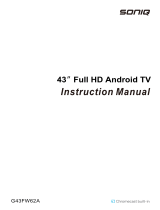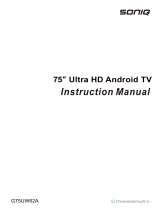
Contents
Guide
Connections
5
Connection Guide
6 Connecting an Antenna
7
Connecting to the Internet
10 Screen Sharing (Smart View) with your Mobile Device
13 Connection Cables for External Devices
15 Switching between external devices connected to the TV
17 Connection Notes
Remote Control and Peripherals
20
About the Samsung Smart Remote
23 About the Samsung Smart Remote (The Frame)
26 About the Samsung Smart Remote (The Sero)
29 Connecting the Samsung Smart Remote to the TV
30 Controlling External Devices with a Samsung Remote
Control - Using the Universal Remote
31
Using Anynet+ (HDMI-CEC)
32
Controlling the TV with a Keyboard, Mouse, or Gamepad
34 Entering Text using the On-Screen Virtual Keyboard
Smart Features
36 Using Smart Hub
45
Using a Samsung account
47
Using the Ambient Mode
53
Using Remote Access
58
Using the Apps Service
62
Using the Gallery App
63
Using the SmartThings App
64
Using the e-Manual
67
Using the Internet
68
Playing pictures/video/music
74
Using Bixby
TV Viewing
78 Using the Guide
81
Recording Programs
83
Setting Up a Schedule Viewing
85
Using Timeshift
85 Buttons and functions available while recording a program
or Timeshift
87 Using the Channel List
88 Editing channels
89 Using a Personal Favorites List
90
TV-Viewing Support Functions
Picture and Sound
93
Using the Intelligent Mode
95 Adjusting the Picture Quality
97 Setting the Viewing Environment for External Devices
99 Changing the Picture Size and Position
100
Conguring a Sound Mode and Expert Settings
102
Using the Sound Support Functions
System and Support
104 Using the Time Functions and the Timers
107 Using the Auto Protection Time and Energy Saving
Functions
108
Updating the TV's Software
109
Audio and Video Functions for the Visually or Hearing
Impaired
114
Using Voice Assistants on TV
115
Using Other Functions
117
Running Data Service Automatically
Precautions and Notes
118 Before Using the Recording and Timeshift Functions
120 Read Before Using Apps
121 Read Before Using the Internet Function
123 Read Before Playing Photo, Video, or Music Files
131 Read After Installing the TV





















